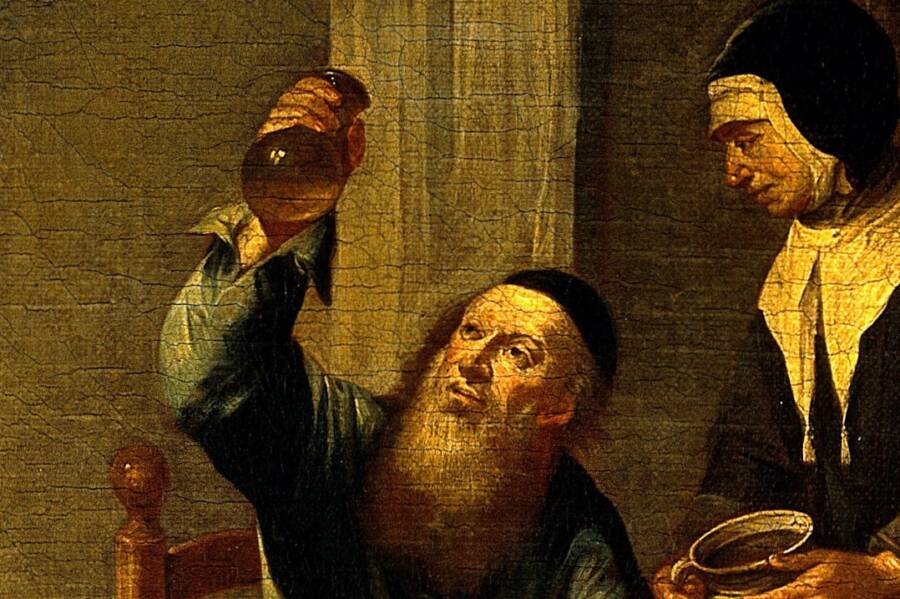Unearthed in the ruins of the Ospedale dei Fornari hospital, flasks like these were used by European doctors for centuries in order to diagnose diseases like jaundice and diabetes.

Sovrintendenza Capitolina/The Caesar’s Forum ProjectRemnants of the urine flasks excavated from a trash dump at Caesar’s Forum in Rome.
Archaeologists in Rome have unearthed a trove of artifacts from the site of a Renaissance-era hospital built atop the ancient Caesar’s Forum. Among these discoveries, most remarkable are 500-year-old urine flasks used for diagnosing ailments in what was one of history’s most bizarre medical practices.
The archaeological team initially excavated this 16th-century hospital’s trash dump in 2021. The site sat within Caesar’s Forum, an ancient symposium built in 46 B.C. to honor Emperor Julius Caesar.
During the Renaissance, a baker’s guild used the space to build their Ospedale dei Fornari, or Baker’s Hospital. Workers at the hospital then created the dump to manage the hospital’s waste, where artifacts lay undisturbed for hundreds of years.
The archeological team partnered with The Caesar’s Forum Project, a Danish-Italian research group dedicated to studying Caesar’s Forum, to examine the hundreds of artifacts at the trash dump.

Sovrintendenza Capitolina/The Caesar’s Forum ProjectThe ruins of Caesar’s Forum today.
The team primarily found ceramic vessels, coins, rosaries, and glassware at the dump site. According to the team’s published findings in the journal Antiquity, they believe these items were once used by patients at the hospital, and that the medical center may have provided patients with a “gift basket” consisting of a jug, drinking glass, bowl and a plate.
However, more than half of the glassware at the dump consisted of matula, the urine flasks once used by doctors across Europe.
Hospital staff used the flasks to collect urine from patients for analysis and observation, including smelling and tasting at times. This practice would have been routine, as the practice of uroscopy, or the study of urine, had been an integral part of medicine as far back as ancient Greece.

Wikimedia CommonsKnown as matula, these flasks allowed doctors to smell and taste patients’ urine in order to diagnose diseases like jaundice and diabetes.
“[A doctor would pour] the patient’s urine into a flask to observe its color, sedimentation, smell, and sometimes even taste,” said project directors Rubina Raja, Jan Kindberg Jacobsen, and Claudio Parisi Presicce.
Analyzing a patient’s urine this way would allow a doctor to determine if he or she had any illnesses, like jaundice, kidney disease, or diabetes.
Historians specifically note that urine tasting was effective in diagnosing diabetes, given the excess glucose in a patient’s urine that would give it a distinct sweet flavor.
According to Gizmodo, one 17th-century English physician, Thomas Willis, described the pee of a diabetes patient as “wonderfully sweet as if it were imbued with honey or sugar.”
After tasting, smelling, and examining the urine, hospital staff would dispose of the urine flasks at the dump. Then, once the dump became full, staff would entomb the site in clay, presumably for sanitary reasons.

Wikimedia CommonsThough the method of smelling and tasting patients’ urine may sound antiquated, it was used across Europe well into the 18th century.
While researchers believe this is the most likely scenario to explain how the urine flasks got to the dump, some question whether the trash dump belonged to the hospital at all.
“The deposition of waste in cellars, courtyards, and cisterns, although prohibited, was a common practice,” Cristina Boschetti, an archaeologist at Aarhus University in Denmark who participated in this study, told Live Science.
While unauthorized trash dumps were common, researchers are sure that their excavation site belonged to the hospital given the types of items they identified there.
Medical historian and independent scholar Monica Green told Live Science that the dump likely belonged to the hospital given its “bespoke ceramicware,” or ceramicware that had been boiled or burned.
The presence of this ceramicware suggests that Renaissance-era doctors boiled and burned them, though it doesn’t necessarily prove that they did this to sterilize them.
“They must have known that at least some kinds of glass could withstand cooking or boiling,” Green told Live Science, but “that doesn’t mean they nevertheless thought in terms of ‘sterilization’.”
With this find, researchers are hopeful that they will be able to study other Renaissance-era hospitals to further examine medical practices in Europe at the time.
In their study’s concluding statement, the team stated that they hope this research will help “highlight the need for a more complete overview of the hygiene and disease control regimes of early modern Europe.”
After reading about these Renaissance-era urine flasks, discover the stomach-turning history of bloodletting. Then, read about the five most painful medical procedures of the medieval era.





